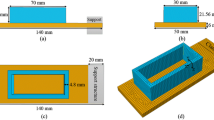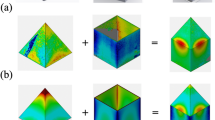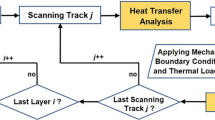Abstract
Laser deposition manufacturing (LDM) technology provides the potential to manufacture large, difficult-to-process metal components for aerospace and other applications. However, the residual stresses resulting from the considerable temperature gradients in the LDM process can lead to distortion and even cracking of the fabricated components. Rapidly predicting the distortion for large additive metal components is critical to controlling the distortion and achieving high-quality forming of large components. Considering the principle of LDM technology, the partitioning method based on typical geometric features for aerospace titanium alloy frames, beams, and wall plates is proposed in this paper. It establishes a rapid prediction method for distortion of large additive metal components based on feature partitioning and temperature function method (TFM) by considering the effect of critical parameters of temperature function on distortion prediction. The results show that the prediction of additive component distortion through this method agrees with the results predicted by the traditional method and experimental results. Furthermore, the computational efficiency of the method has improved by 96% compared to the traditional approach, meeting the need for rapid distortion prediction in large metal additive components.



















Similar content being viewed by others
References
DebRoy T, Wei HL, Zuback JS, Mukherjee T, Elmer JW, Milewski JO, Beese AM, Wilson-Heid A, De A, Zhang W (2018) Additive manufacturing of metallic components – process, structure and properties. Prog Mater Sci 92:112–224. https://doi.org/10.1016/j.pmatsci.2017.10.001
Carpenter K, Tabei A (2020) On residual stress development prevention and compensation in metal additive manufacturing. Materials 13(2):255. https://doi.org/10.3390/ma13020255
Lu XF, Lin X, Michele C, Miguel C, Hu YL, Ji XL, Ma L, Huang WD (2019) In situ measurements and thermo-mechanical simulation of Ti–6Al–4V laser solid forming processes. Int J Mech Sci 153–154:119–130. https://doi.org/10.1016/j.ijmecsci.2019.01.043
Lu XF, Lin X, Michele C, Miguel C, Li JJ, Ma L, Wei L, Hu YL, Huang WD (2018) Finite element analysis and experimental validation of the thermomechanical behavior in laser solid forming of Ti-6Al-4V. Addit Manuf 21:30–40. https://doi.org/10.1016/j.addma.2018.02.003
Strantza M, Ganeriwala RK, Clausen B, Phan TQ, Levine LE, Pagan D, King WE, Hodge NE, Brown DW (2018) Coupled experimental and computational study of residual stresses in additively manufactured Ti-6Al-4V components. Mater Lett 231:221–224. https://doi.org/10.1016/j.matlet.2018.07.141
Mukherjee T, Zhang W, DebRoy T (2017) An improved prediction of residual stresses and distortion in additive manufacturing. Comput Mater Sci 126:360–372. https://doi.org/10.1016/j.commatsci.2016.10.003
Lai YB, Liu WJ, Zhao JB, Zhao YH, Wang FY, Han WC (2013) Experimental study on residual stress in titanium alloy laser additive manufacturing. Appl Mech Mater 431:6–20. https://doi.org/10.4028/www.scientific.net/amm.431.20
Lu XF, Lin X, Michele C, Miguel C, Hu YL, Ji XL, Ma L, Yang H, Huang WD (2019) Residual stress and distortion of rectangular and S-shaped Ti-6Al-4V parts by directed energy deposition: modelling and experimental calibration. Addit Manuf 26:166–179. https://doi.org/10.1016/j.addma.2019.02.001
Fallah V, Amoorezaei M, Provatas N, Corbin SF, Khajepour A (2012) Phase-field simulation of solidification morphology in laser powder deposition of Ti–Nb alloys. Acta Mater 60(4):1633–1646. https://doi.org/10.1016/j.actamat.2011.12.009
Michaleris P (2014) Modeling metal deposition in heat transfer analyses of additive manufacturing processes. Finite Elem Anal Des 86:51–60. https://doi.org/10.1016/j.finel.2014.04.003
Denlinger ER, Irwin J, Michaleris P (2014) Thermomechanical modeling of additive manufacturing large parts. J Manuf Sci Eng 136(6):061007. https://doi.org/10.1115/1.4028669
Yuan M, Ueda Y (1996) Prediction of residual stresses in welded T-and I-joints using inherent strains. J Eng Mater Technol 118(2):229–234. https://doi.org/10.1115/1.2804892
Liang X, Chen Q, Cheng L, Hayduke D, To AC (2019) Modified inherent strain method for efficient prediction of residual deformation in direct metal laser sintered components. Comput Mech 64:1719–1733. https://doi.org/10.1007/s00466-019-01748-6
Liang X, Cheng L, Chen Q, Yang QC, To AC (2018) A modified method for estimating inherent strains from detailed process simulation for fast residual distortion prediction of single-walled structures fabricated by directed energy deposition. Addit Manuf 23:471–486. https://doi.org/10.1007/s00466-019-01748-6
Liang X, Dong W, Hinnebusch S, Chen Q, Tran HT, Lemon J, Cheng L, Zhou ZK, Hayduke D, To AC (2020) Inherent strain homogenization for fast residual deformation simulation of thin-walled lattice support structures built by laser powder bed fusion additive manufacturing. Addit Manuf 32:101091. https://doi.org/10.1016/j.addma.2020.101091
Cao Y, Lin X, Kang N, Ma L, Wei L, Zheng M, Yu J, Peng DJ, Huang WD (2021) A novel high-efficient finite element analysis method of powder bed fusion additive manufacturing. Addit Manuf 46:102187. https://doi.org/10.1016/j.addma.2021.102187
Zeng K, Deepankar P, Teng C, Stucker BE (2015) Evaluations of effective thermal conductivity of support structures in selective laser melting. Addit Manuf 6:67–73. https://doi.org/10.1016/j.addma.2015.03.004
Baiges J, Chiumenti M, Moreira CA, Cervera M, Codina R (2021) An adaptive Finite Element strategy for the numerical simulation of additive manufacturing processes. Addit Manuf 37:101650. https://doi.org/10.1016/j.addma.2020.101650
Bayat M, Klingaa CG, Mohanty S, Baere DD, Thorborg J, Tiedje NS, Hattel JH (2020) Part-scale thermo-mechanical modelling of distortions in laser powder bed fusion – analysis of the sequential flash heating method with experimental validation. Addit Manuf 36:101508. https://doi.org/10.1016/j.addma.2020.101508
Zaeh MF, Branner G (2010) Investigations on residual stresses and deformations in se-lective laser melting. Prod Eng Res Devel 4(1):35–45. https://doi.org/10.1007/s11740-009-0192-y
Prabhakar P, Sames WJ, Dehoff R, Babu SS (2015) Computational modeling of residual stress formation during the electron beam melting process for Inconel 718. Addit Manuf 7:83–91. https://doi.org/10.1016/j.addma.2015.03.003
Zhang WY, Tong MM, Harrison NM (2019) Resolution, energy and time dependency on layer scaling in finite element modelling of laser beam powder bed fusion additive manufacturing. Addit Manuf 28:610–620. https://doi.org/10.1016/j.addma.2019.05.002
Ding J, Colegrove P, Mehnen J, Williams S, Wang F, Almeida PS (2014) A computationally efficient finite element model of wire and arc additive manufacture. Int J Adv Manuf Technol 70:227–236. https://doi.org/10.1007/s00170-013-5261-x
Nadammal N, Mishurova T, Fritsch T, Munoz IS, Kromm A, Haberland C, Portella PD, Bruno G (2021) Critical role of scan strategies on the development of microstructure, texture, and residual stresses during laser powder bed fusion additive manufacturing. Addit Manuf 38:101792. https://doi.org/10.1016/j.addma.2020.101792
Ramani KS, He C, Tsai YL, Okwudire CE (2022) SmartScan: An intelligent scanning approach for uniform thermal distribution, reduced residual stresses and deformations in PBF additive manufacturing. Addit Manuf 52:102643. https://doi.org/10.1016/j.addma.2022.102643
Parry L, Ashcroft IA, Wildman RD (2016) Understanding the effect of laser scan strategy on residual stress in selective laser melting through thermo-mechanical simulation. Addit Manuf 12:1–15. https://doi.org/10.1016/j.addma.2016.05.014
Fallah V, Alimardani M, Corbin SF, Khajepour A (2011) Temporal development of melt-pool morphology and clad geometry in laser powder deposition. Comput Mater Sci 50(7):2124–2134. https://doi.org/10.1016/j.commatsci.2011.02.018
Yang QC, Zhang P, Cheng L, Min Z, Chyu M, To AC (2016) Finite element modeling and validation of thermomechanical behavior of Ti-6Al-4V in directed energy deposition additive manufacturing. Addit Manuf 12(B):169–177. https://doi.org/10.1016/j.addma.2016.06.012
Zheng M, Wei L, Chen J, Zhang Q, Zhong CL, Lin X, Huang WD (2019) A novel method for the molten pool and porosity formation modelling in selective laser melting. Int J Heat Mass Transf 140:1091–1105. https://doi.org/10.1016/j.ijheatmasstransfer.2019.06.038
Funding
This work was supported by the National Key Research and Development Program of China (Grant No. 2022YFE0122600) and the Central Guidance on Local Science and Technology Development Fund of Liaoning Province (Grant No. 2023JH6/100100044), and National natural science foundation of China (52105386, 51975387).
Author information
Authors and Affiliations
Corresponding author
Ethics declarations
Ethics approval
Not applicable.
Consent to participate
Not applicable.
Consent for publication
This work is approved by all authors for publication.
Competing interests
The authors declare no competing interests.
Additional information
Publisher's Note
Springer Nature remains neutral with regard to jurisdictional claims in published maps and institutional affiliations.
Rights and permissions
Springer Nature or its licensor (e.g. a society or other partner) holds exclusive rights to this article under a publishing agreement with the author(s) or other rightsholder(s); author self-archiving of the accepted manuscript version of this article is solely governed by the terms of such publishing agreement and applicable law.
About this article
Cite this article
Li, B., Zhang, J., Yin, J. et al. Distortion prediction method for large-scale additive metal components based on feature partitioning and temperature function method. Int J Adv Manuf Technol 130, 1373–1391 (2024). https://doi.org/10.1007/s00170-023-12822-y
Received:
Accepted:
Published:
Issue Date:
DOI: https://doi.org/10.1007/s00170-023-12822-y




